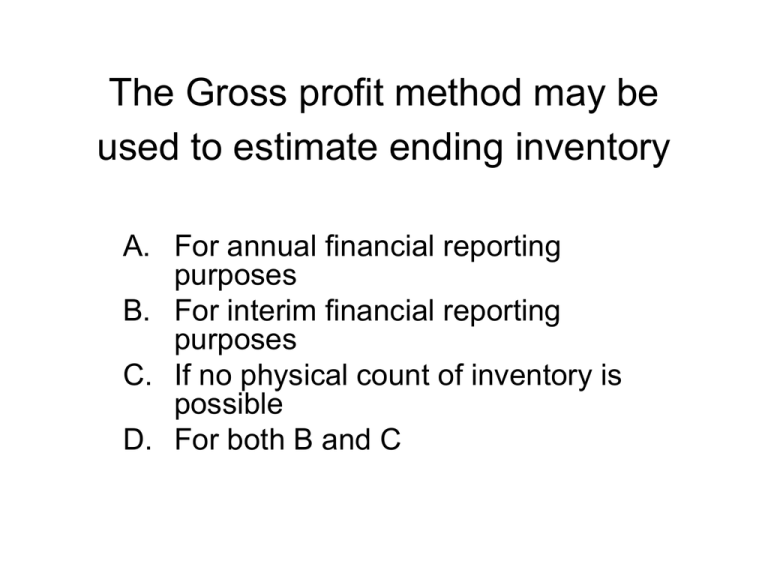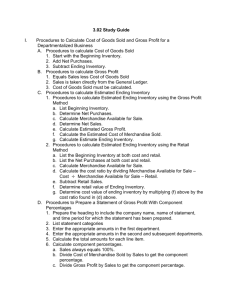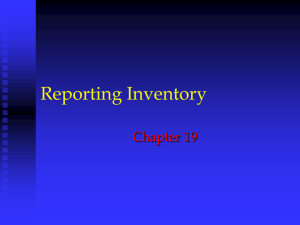The Gross profit method may be used to estimate ending inventory
advertisement

The Gross profit method may be used to estimate ending inventory A. For annual financial reporting purposes B. For interim financial reporting purposes C. If no physical count of inventory is possible D. For both B and C Gross profit method • Relies on the relationship between Price (sales); cost and gross profit: $ as % of sales cost • Sales $150 100 214 • -cost of goods sold $- 70 47 100 • Gross profit $ 80 53 114 Gross profit method: Sales: $200; gross profit on sales: 45% A. B. C. D. Cost of goods sold: Cost of goods sold: Cost of goods sold: Cost of goods sold: $90 Gross profit: $110 $62; Gross profit: $138 $110; Gross profit: $90 $138; Gross profit: $62 Gross profit method: Sales: $200; gross profit on cost: 45% A. B. C. D. Cost of goods sold: Cost of goods sold: Cost of goods sold: Cost of goods sold: $90; Gross profit: $110 $62; Gross profit: $138 $110; Gross profit: $90 $138; Gross profit: $62 E 9-16 • Determine the amount of ending inventory before the fire E 9-8 1. Determine the gross profit realized in 2004 2. Determine the ending inventory The Retail inventory method may be used to estimate ending inventory A. For annual financial reporting purposes B. For interim financial reporting purposes C. If no physical count of inventory is possible D. For both B and C E 9-22 Determine ending inventory 1. Using the conventional retail method 2. Using LIFO retail method Retail - LIFO • Makes no sense • Ignores change in prices – which is what LIFO is all about. • Therefore, need to combine Retail method with $ value method - $value retail LIFO. $value retail LIFO need to know: • Beginning inventory at cost and retail • Purchases at cost and retail • Cost/Retail Ratios for beginning inventory and purchases • Sales at retail • Price index for beginning inventory (may have several layers!) • Price index for purchases. $value retail LIFO procedure • Part I: Determine additional layer if any at base retail • Same as for basic $ value LIFO method EXCEPT: done with retail, NOT cost • Part II: Convert new layer from base to current prices • Part III: convert new layer from retail to cost and add beginning inventory at cost E 9-27 Determine ending inventory, using the $ value retail LIFO method for 1. 2. 3. 4. 2003 2004 2005 2006 Problem 9-12 Determine the total estimated ending inventory using the LIFO retail inventory method A. At retail B. At cost Problem 9-12 Determine the amount of shrinkage A. At retail B. At cost Application of the Lower of Cost or Market method results in A. The most relevant ending inventory figure B. The most reliable ending inventory figure C. The most conservative ending inventory figure D. Both B and C Which of the following is considered the ceiling for LCM purposes? A. B. C. D. E. Cost Replacement cost Selling price Net realizable value Net realizable value minus normal profit Which of the following is considered the floor for LCM purposes? A. B. C. D. E. Cost Replacement cost Selling price Net realizable value Net realizable value minus normal profit Problem 9-2 Determine the LCM ending inventory value for A. B. C. D. Aluminum siding Cedar shake siding Louvered glass doors Thermal windows Problem 9-2 Determine the total amount of loss from write down of inventory to be recognized in 2004 Answers




